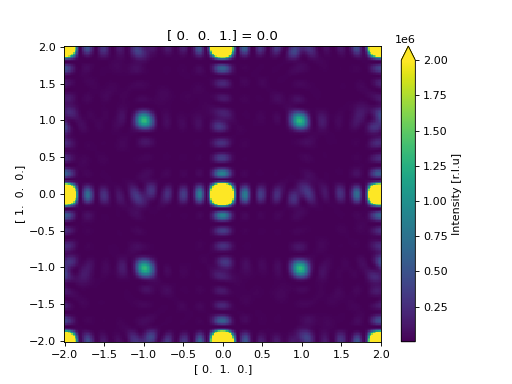Working with DISCUS¶
Javelin is inspired by DISCUS Until javelin has become feature equivalent to DISCUS for disordered strcuture creation DISCUS can still be used to create structures. While javelin can be used to calculate the diffuse scattering and compare to experimental data.
Javelin can read in discus structure files simply by:
>>> from javelin.io import read_stru
>>> structure = read_stru("tests/data/pzn2.stru")
Found a = 4.06, b = 4.06, c = 4.06, alpha = 90.0, beta = 90.0, gamma = 90.0
Read in these atoms:
Nb 80
O 375
Pb 125
Zn 45
Name: symbol, dtype: int64
>>> print(structure)
Structure(Nb80O375Pb125Zn45, a=4.06, b=4.06, c=4.06, alpha=90.0, beta=90.0, gamma=90.0)
From here it’s easy to calculate the scattering.
>>> from javelin.io import read_stru # doctest: +SKIP
>>> structure = read_stru("../../tests/data/pzn2.stru") # doctest: +SKIP
Found a = 4.06, b = 4.06, c = 4.06, alpha = 90.0, beta = 90.0, gamma = 90.0
Read in these atoms:
Nb 80
O 375
Pb 125
Zn 45
Name: symbol, dtype: int64
>>> from javelin.fourier import Fourier # doctest: +SKIP
>>> fourier = Fourier() # doctest: +SKIP
>>> fourier.grid.r1 = -2, 2 # doctest: +SKIP
>>> fourier.grid.r2 = -2, 2 # doctest: +SKIP
>>> fourier.grid.bins = 201, 201 # doctest: +SKIP
>>> print(fourier) # doctest: +SKIP
Structure : Structure(Nb80O375Pb125Zn45, a=4.06, b=4.06, c=4.06, alpha=90.0, beta=90.0, gamma=90.0)
Radiation : neutron
Fourier volume : complete crystal
Aver. subtraction : False
<BLANKLINE>
Reciprocal layer :
lower left corner : [-2. -2. 0.]
lower right corner : [ 2. -2. 0.]
upper left corner : [-2. 2. 0.]
top left corner : [-2. -2. 1.]
<BLANKLINE>
hor. increment : [ 0.02 0. 0. ]
vert. increment : [ 0. 0.02 0. ]
top increment : [ 0. 0. 1.]
<BLANKLINE>
# of points : 201 x 201 x 1
>>> results = fourier.calc(structure) # doctest: +SKIP
Working on atom number 8 Total atoms: 375
Working on atom number 30 Total atoms: 45
Working on atom number 41 Total atoms: 80
Working on atom number 82 Total atoms: 125
>>> results.plot(vmax=2e6) # doctest: +SKIP
<matplotlib.collections.QuadMesh object at ...>
(Source code, png, hires.png, pdf)
